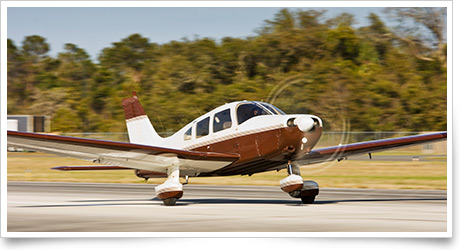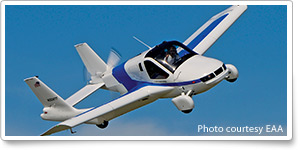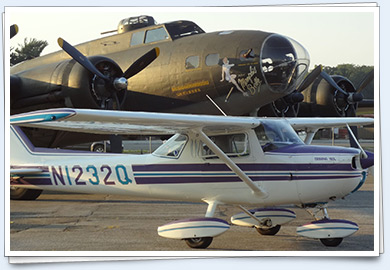|
|||||
Training TipsFixed standards, variable conditions
That’s essential prep. Although the practical test standards define acceptable performance, every runway and every set of weather conditions shape what’s required to achieve it. How you incorporate that reality into your demonstration will speak volumes about your abilities—and judgment.
Your instructor is playing the role of designated examiner for this rehearsal, saying little but observing closely as you taxi to the runway of the nontowered airport to demonstrate a soft-field takeoff.
It was a wise first step to review the departure process before engine start. The taxi route crosses another runway, requiring care and vigilance. And the takeoff will call for some very specific decisions.
Given today’s surface winds, you will take off from 3,200-foot-long Runway 22, which has a displaced threshold and a stand of high trees off the departure end. Also, the other runway intersects it at the approximate point where you will become airborne—something not to overlook when complying with the requirement to use “procedures before taxiing onto the runway or takeoff area to ensure runway incursion avoidance.” (In other words, don’t just verify “no aircraft on final” on the “active” runway. Give the other runway’s traffic pattern equal scrutiny, even if the common traffic advisory frequency is silent.)
As you complete your pre-takeoff checklist, your “examiner” speaks up, asking whether you can use the portion of the runway “behind” the displaced threshold for takeoff.
Don’t let the question distract you! At a logical stopping point in your checklist review, explain that “the portion of runway behind a displaced threshold is available for takeoffs in either direction and landings from the opposite direction.”
It’s a hot day with high density altitude, so those high trees off the departure end are a factor in your planning. For the best safety margin, you have decided that after liftoff at the lowest possible airspeed, as required, you will accelerate to Vx, best-angle-of-climb speed, and maintain it to a safe maneuvering altitude.
A soft-field takeoff under other conditions or from another airport would likely raise a completely different set of considerations for your planning. Soon you will demonstrate to a real designated examiner that you can make the right calls in every instance. Flight Training NewsRevised training standards releasedMembers of the general aviation community can now review new draft airman certification standards for authorized instructors, and can study revisions to previously released draft certification standards for the private pilot certificate and the instrument rating. Comments may be submitted on all three publications until Aug. 23. Read more >> College students earn exceptions to new 1,500-flight-hour ruleA new rule recently announced by the FAA increases qualification requirements for first officers who fly for U.S. passenger and cargo airlines, but includes allowances for reduced hours for pilots holding bachelor’s degrees with an aviation major. Embry-Riddle Aeronautical University touted this advantage, adding that students at Embry-Riddle also have access to full-motion simulation training “like no other university in the United States.” Deadline approaching for ‘Flight Training’ awards pollWith time running out to nominate a flight instructor or flight school for a Flight Training Excellence Award, share your feedback by taking a quick online poll by the Aug. 9 deadline and share your feedback. Flight Training and AOPA’s Center to Advance the Pilot Community are targeting anyone who has had some type of flight training in the last two years to participate in the poll. Read more >> Apps can help you learn aircraft instrumentsGoing long periods of time between flight lessons or personal flights? Check out these apps that simulate the flight and radio navigation instruments in common aircraft to help keep your skills sharp. Read more >> Black box could increase safety, efficiency of collegiate flight trainingFlight operations quality assurance, or FOQA, the system contained in an aircraft's black box, could improve the safety of collegiate flight training programs in the future, according to research conducted by J.D. Swinney, one of the first two graduates of Kansas State University Salina's professional Master of Technology degree program. “FOQA has been proven to enhance commercial aviation safety, allowing airlines to objectively monitor how aircraft are being operated,” Swinney said. “We can apply those same concepts to general aviation, where FOQA is mostly absent, and more specifically, to collegiate training programs.” Take the RNAV chart challengeAcross the country, RNAV approaches are becoming increasingly popular because of the rise in panel-mounted GPS units. These approaches aren’t hard to fly, but they are different than the procedures most pilots are used to. Learn more about this type of instrument approach by taking the Air Safety Institute’s IFR Chart Challenge: RNAV Approach online course. Log in to take the course >> Risk versus rewardPilots maneuver on every flight, but improperly done maneuvering flight—especially when close to the ground—can be hazardous. Luckily, there are numerous things pilots can do to minimize the risks of this phase of flight. Learn more about the “dos and don’ts” when maneuvering with the Air Safety Institute’s Maneuvering Flight Safety Advisor. Read the Advisor >> ScholarshipsNinety-Nines revise new pilot scholarshipThe International Organization of Women Pilots (The Ninety-Nines) has revamped its former New Pilot Scholarship to make the award progressive so that recipients receive funds after completing milestones in their training. Now known as the Fly Now Scholarship, the program is open to associate members of The Ninety-Nines who demonstrate a need for financial assistance to become certificated pilots. Read more >> Three students win AIAA Foundation's 2013 Iridium Next ScholarshipThe American Institute of Aeronautics and Astronautics Foundation (AIAA Foundation) has chosen three students for Iridium Next Scholarships, which target those who have demonstrated a very high standard of academic excellence in science, technology, engineering, and mathematics. The 2013 winners are Eric McVay, The University of Alabama, who received a $20,000 scholarship; Chelsea Welch, University of Colorado, who received a $10,000 scholarship; and Christopher Nie, University of Colorado, who received a $5,000 scholarship. Southern California Aviation Association offers type rating scholarshipThe Southern California Aviation Association (SCAA) is partnering with ProFlight to offer a Cessna CJ type rating training award. Applicants must reside in Southern California, from San Diego to Santa Barbara; meet requirements for airline transport pilot; and be nominated by an aviation professional. The deadline to apply is Aug. 30. Silver Wings Fraternity awards scholarshipThe Silver Wings Fraternity has donated $1,250 to Pensacola, Fla.-based National Flight Academy to fund a scholarship, reports General Aviation News. The organization's aviation scholarship program makes annual donations to nonprofit aviation educational organizations. Training Resources‘Essential Aerodynamics’Getting a handle on aerodynamics doesn't have to involve dry textbooks and dense equations. In the Air Safety Institute course Essential Aerodynamics: Stalls, Spins, and Safety, you’ll learn need-to-know concepts that will help you avoid unintentional stalls and spins. Take the course >>
Did you know that student pilots who join AOPA are three times more likely to complete their flight training? Membership includes unlimited access to aviation information by phone (800/USA-AOPA, weekdays from 8:30 a.m. to 8 p.m. Eastern time) or from Flight Training Online or AOPA Online. If you’re not already a member, join today and get the pilot’s edge.
Jetman flies over Oshkosh, diesel power at EAA AirVentureAOPA Live® crews are right in the thick of things at EAA AirVenture in Oshkosh, Wis., as the general aviation world gathers to make news and take in the views. This special edition of AOPA Live This Week includes a look at the diesel-powered RedHawk trainer, and “Jetman” Yves Rossy making a flight over the show. Rod Machado’s License to Learn feature covers coordination, and AOPA will give you an up-close look at the AOPA Sweepstakes Debonair’s new panel. AOPA Live This Week, Aug. 1. Career PilotUPS pilot union joins international federationThe Independent Pilots Association, the union representing 2,600 UPS airline pilots, has become a member of the International Transport Workers' Federation, a global alliance of unions representing transportation workers, IPA announced July 18. “ITF membership gives us instant access to unions representing UPS workers around the globe,” said Capt. Robert Travis, IPA president. “The IPA’s acceptance into the organization is well timed given our ongoing contract negotiations with UPS.” Founded in 1896, ITF is an alliance of more than 700 transportation trade unions representing more than 4.5 million workers in 150 countries. It holds representational status with international bodies such as the International Civil Aviation Organization (ICAO) and the International Labor Organization. Horizon Air flight attendants ratify five-year contractHorizon Air flight attendants have approved a new five-year contract. The ratification vote concluded July 18, with 75 percent of the participating flight attendants voting in favor of the agreement. The new contract includes pay raises, quality of life improvements, and more flexible scheduling. The agreement becomes amendable on July 18, 2018. The previous contract became amendable on Dec. 21, 2011. Labor agreements in the airline industry do not expire; they become amendable and remain in effect until a new contract is ratified. Horizon Air is an Alaska Air Group subsidiary that flies to 39 cities across the United States, Canada, and Mexico.
For more aviation career news, see the Flight Training website. Plane SpotterStill every driver’s dream
Training ProductsFAA offers takeoff safety publicationThe FAA has released the Pilot Guide to Takeoff Safety, created to reduce the number of rejected-takeoff-related accidents by improving the pilot’s decision making and associated procedural accomplishment through increased knowledge and awareness of the factors affecting the successful outcome of the “go/no go” decision. AOPA student glossary for general aviationAviation acronyms and terms can be overwhelming for student pilots. So keep this student glossary handy to look up any unfamiliar terms.
Note: Products listed have not been evaluated by ePilot editors unless otherwise noted. AOPA assumes no responsibility for products or services listed or for claims or actions by manufacturers or vendors. Member BenefitsMedical certification for the new student pilotFirst of all, welcome to the world of general aviation, writes Gary Crump, AOPA's director of medical certification. Learning to fly is a tremendous life accomplishment that can open many doors to learning and adventure. And learn you will—there is a lot of knowledge to be gained as you work toward your private pilot certificate. One of the first things you will need to focus on is obtaining a medical certificate. Read more >> BlogsA flight lesson and a weddingWhen AOPA Technical Editor Jill Tallman interviewed Jeff Vandeyacht, owner of True Course Flight School in Fulton, N.Y., about the challenges of taking over a flight school and making it a sustainable business for the March 2011 Flight Training, she had no idea he was so multitalented. Tallman has gotten to know Vandeyacht a little bit thanks to Facebook, and she can tell you that he’s a CFI (obviously), an entrepreneur, and a dog owner. Now add “ordained minister” to the list. Read more >> AOPA Career OpportunitiesEver dream of turning your passion for aviation into a career? We’re looking for an AOPA Live editor/graphic artist. To learn more about other AOPA career opportunities, visit AOPA Online. Community
AVIATION EVENTS & WEATHER
|
||||||||||||||||||||||||||||||||||||

 Checkride day is coming. Today’s prep session will focus on takeoffs and landings, especially on planning how you will perform the assigned technique given this particular runway and today’s conditions.
Checkride day is coming. Today’s prep session will focus on takeoffs and landings, especially on planning how you will perform the assigned technique given this particular runway and today’s conditions.



